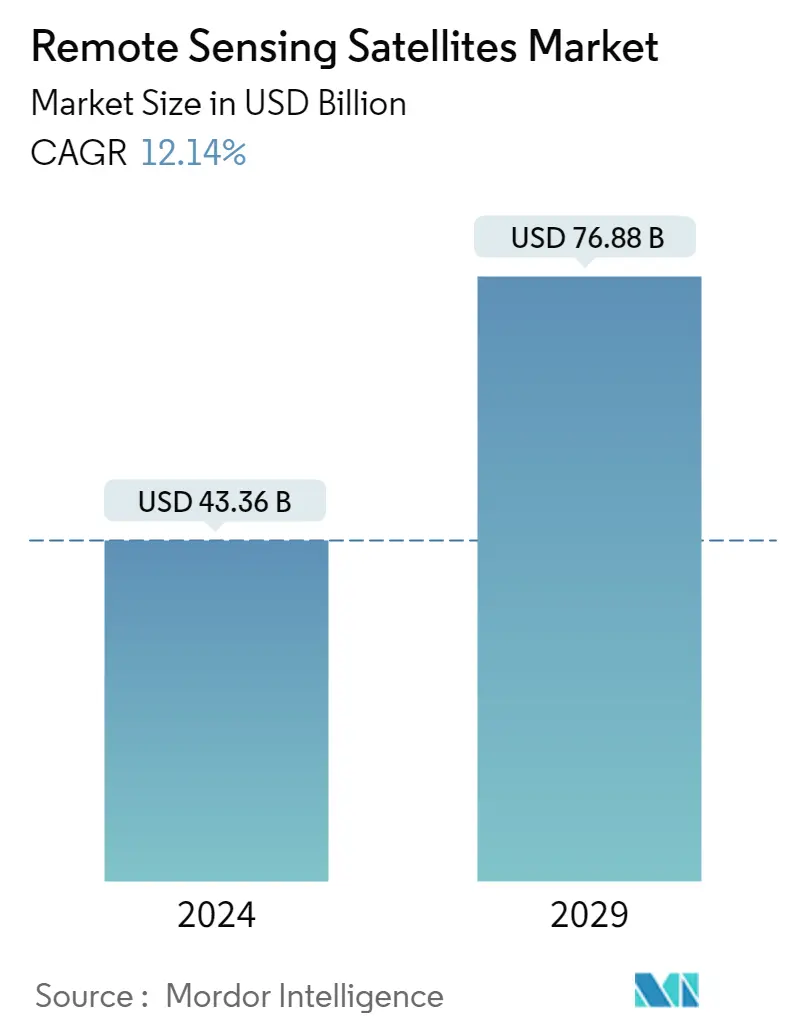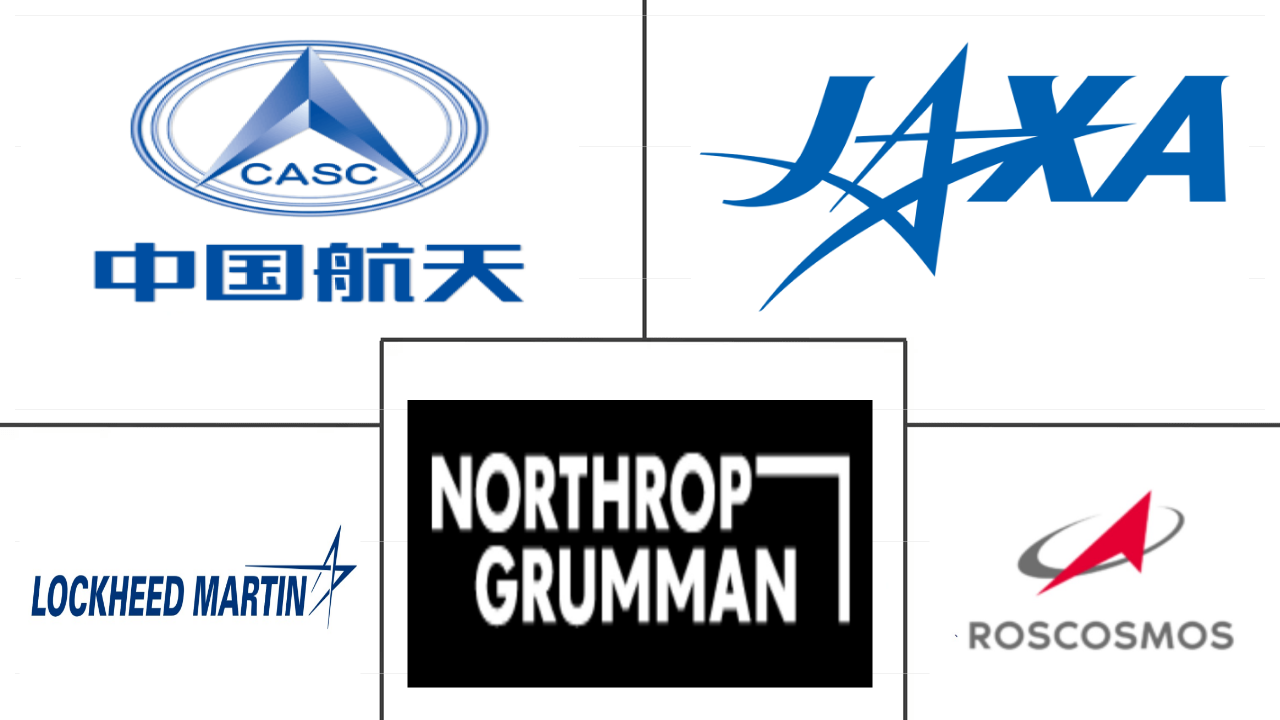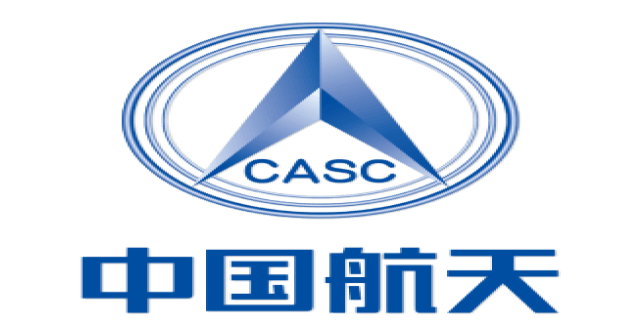Market Size of remote sensing satellites Industry

|
|
Study Period | 2017 - 2029 |
|
|
Market Size (2024) | USD 43.36 Billion |
|
|
Market Size (2029) | USD 76.88 Billion |
|
|
Largest Share by Orbit Class | LEO |
|
|
CAGR (2024 - 2029) | 12.14 % |
|
|
Largest Share by Region | North America |
Major Players |
||

|
||
|
*Disclaimer: Major Players sorted in no particular order |
Remote Sensing Satellite Market Analysis
The Remote Sensing Satellites Market size is estimated at USD 43.36 billion in 2024, and is expected to reach USD 76.88 billion by 2029, growing at a CAGR of 12.14% during the forecast period (2024-2029).
43.36 Billion
Market Size in 2024 (USD)
76.88 Billion
Market Size in 2029 (USD)
10.57 %
CAGR (2017-2023)
12.14 %
CAGR (2024-2029)
Largest Market by Satellite Mass
76.63 %
value share, above 1000kg, 2022
Large satellites register higher demand due to applications such as satellite radio, communications, remote sensing, planetary security, and weather forecasting.
Largest Market by Satellite Subsystem
42.50 %
value share, Propulsion Hardware and Propellant, 2022
The demand for these propulsion systems is driven by the launch of mass satellite constellations into space. They are used for transferring the spacecraft into orbit.
Largest Market by Orbit Class
87.05 %
value share, LEO, 2022
LEO satellites are increasingly being adopted in modern communication technologies as they play an important role in Earth observation applications.
Largest Market by End User
92.71 %
value share, Military & Government, 2022
The military and government segment is expected to grow significantly due to the increasing use of satellites in surveillance missions and the rising involvement of government space agencies in satellite development programs.
Leading Market Player
38.72 %
market share, China Aerospace Science and Technology Corporation (CASC), 2022

China Aerospace Science and Technology Corporation (CASC) is the largest player in the market. It offers a diverse range of launch vehicles and adopts a competitive pricing strategy to attract customers globally.
Demand for LEO satellites is driving the market and registers a share of 79.5% in 2029
- Various remote sensing satellites orbit the Earth at varying distances depending on their design and primary purpose. These satellites are launched or placed into different orbits according to their purposes/applications. Each satellite deployed into orbit has its own benefits and challenges, which include increased coverage and decreased energy efficiency.
- Around 90% of the remote sensing satellites launched between 2017 and 2022* were placed in low Earth orbit for Earth observation and science, among other applications. This is because of the close proximity of this orbit to the Earth, which helps send spatial high-resolution images without any latency. Therefore, with the increased benefits of this orbit, the demand for these satellites to be deployed in the LEO orbit is expected to rise during the forecast period. Similarly, during 2017-2022, of the 56 satellites launched in the MEO orbit, 46 were built for Navigation/Global Positioning purposes. Of the 147 satellites in the GEO orbit, 105 satellites have been deployed for communication applications.
- The increasing use of remote sensing satellites for purposes such as electronic intelligence, Earth science/meteorology, laser imaging, optical imaging, and meteorology is expected to drive the demand for the remote sensing satellites market during the forecast period.
Asia-Pacific is expected to witness highest growth during the forecast period
- The global remote sensing satellite market is expected to grow significantly over the coming years, driven by increasing demand for high-speed internet, communication services, and data transfer across different industries. North America, Europe, and Asia-Pacific are the major regions in terms of market share and revenue generation. During 2017-2022, a total of 147 remote sensing satellites were manufactured and launched.
- North America is expected to dominate the global remote sensing satellite market due to the presence of several leading market players, such as Boeing, Lockheed Martin, and Northrop Grumman, in the region. The US government is also investing heavily in the development of advanced satellite technology, which is expected to drive the growth of the market in North America. During 2017-2022, the region accounted for 30% of the total remote sensing satellites manufactured.
- The remote sensing satellite market in Europe is expected to grow significantly due to the increasing demand for high-speed internet and communication services. The European Space Agency (ESA) has been investing heavily in the development of advanced satellite technology, which is expected to drive the growth of the market in the region. During 2017-2022, the region accounted for 11% of the total remote sensing satellites manufactured.
- Asia-Pacific is expected to witness significant growth in the remote sensing satellite market due to the increasing demand for satellite-based communication services and navigation systems in countries such as China, India, and Japan. During 2017-2022, the region accounted for 59% of the total remote sensing satellites manufactured.
Remote Sensing Satellites Industry Segmentation Remote Sensing Satellite Industry Segmentation
10-100kg, 100-500kg, 500-1000kg, Below 10 Kg, above 1000kg are covered as segments by Satellite Mass. GEO, LEO, MEO are covered as segments by Orbit Class. Propulsion Hardware and Propellant, Satellite Bus & Subsystems, Solar Array & Power Hardware, Structures, Harness & Mechanisms are covered as segments by Satellite Subsystem. Commercial, Military & Government are covered as segments by End User. Asia-Pacific, Europe, North America are covered as segments by Region.
- Various remote sensing satellites orbit the Earth at varying distances depending on their design and primary purpose. These satellites are launched or placed into different orbits according to their purposes/applications. Each satellite deployed into orbit has its own benefits and challenges, which include increased coverage and decreased energy efficiency.
- Around 90% of the remote sensing satellites launched between 2017 and 2022* were placed in low Earth orbit for Earth observation and science, among other applications. This is because of the close proximity of this orbit to the Earth, which helps send spatial high-resolution images without any latency. Therefore, with the increased benefits of this orbit, the demand for these satellites to be deployed in the LEO orbit is expected to rise during the forecast period. Similarly, during 2017-2022, of the 56 satellites launched in the MEO orbit, 46 were built for Navigation/Global Positioning purposes. Of the 147 satellites in the GEO orbit, 105 satellites have been deployed for communication applications.
- The increasing use of remote sensing satellites for purposes such as electronic intelligence, Earth science/meteorology, laser imaging, optical imaging, and meteorology is expected to drive the demand for the remote sensing satellites market during the forecast period.
| Satellite Mass | |
| 10-100kg | |
| 100-500kg | |
| 500-1000kg | |
| Below 10 Kg | |
| above 1000kg |
| Orbit Class | |
| GEO | |
| LEO | |
| MEO |
| Satellite Subsystem | |
| Propulsion Hardware and Propellant | |
| Satellite Bus & Subsystems | |
| Solar Array & Power Hardware | |
| Structures, Harness & Mechanisms |
| End User | |
| Commercial | |
| Military & Government | |
| Other |
| Region | |
| Asia-Pacific | |
| Europe | |
| North America | |
| Rest of World |
Remote Sensing Satellites Market Size Summary
The remote sensing satellite market is poised for substantial growth, driven by the increasing demand for advanced satellite technology across various applications such as Earth observation, communication, and navigation. These satellites are strategically placed in different orbits, with a significant portion deployed in low Earth orbit due to its advantages in providing high-resolution images with minimal latency. The market is characterized by the rising use of remote sensing satellites for diverse purposes, including electronic intelligence and meteorology, which is expected to fuel demand during the forecast period. The proliferation of small satellites, which offer cost-effective solutions for traditional satellite functions, is further enhancing market dynamics, with regions like North America, Europe, and Asia-Pacific leading in manufacturing and launching these satellites.
North America is anticipated to maintain its dominance in the remote sensing satellite market, supported by the presence of major industry players and substantial government investments in satellite technology. The European market is expected to grow significantly, driven by the European Space Agency's initiatives and increasing demand for communication services. Meanwhile, the Asia-Pacific region is witnessing rapid expansion due to the burgeoning demand for satellite-based communication and navigation systems, particularly in countries like China, India, and Japan. The market is fairly consolidated, with key players such as China Aerospace Science and Technology Corporation, Japan Aerospace Exploration Agency, and Lockheed Martin Corporation playing pivotal roles. These developments underscore the strategic importance of remote sensing satellites in global communication, navigation, and Earth observation efforts.
Remote Sensing Satellites Market Size - Table of Contents
-
1. MARKET SEGMENTATION (includes market size in Value in USD, Forecasts up to 2029 and analysis of growth prospects)
-
1.1 Satellite Mass
-
1.1.1 10-100kg
-
1.1.2 100-500kg
-
1.1.3 500-1000kg
-
1.1.4 Below 10 Kg
-
1.1.5 above 1000kg
-
-
1.2 Orbit Class
-
1.2.1 GEO
-
1.2.2 LEO
-
1.2.3 MEO
-
-
1.3 Satellite Subsystem
-
1.3.1 Propulsion Hardware and Propellant
-
1.3.2 Satellite Bus & Subsystems
-
1.3.3 Solar Array & Power Hardware
-
1.3.4 Structures, Harness & Mechanisms
-
-
1.4 End User
-
1.4.1 Commercial
-
1.4.2 Military & Government
-
1.4.3 Other
-
-
1.5 Region
-
1.5.1 Asia-Pacific
-
1.5.2 Europe
-
1.5.3 North America
-
1.5.4 Rest of World
-
-
Remote Sensing Satellites Market Size FAQs
How big is the Remote Sensing Satellites Market?
The Remote Sensing Satellites Market size is expected to reach USD 43.36 billion in 2024 and grow at a CAGR of 12.14% to reach USD 76.88 billion by 2029.
What is the current Remote Sensing Satellites Market size?
In 2024, the Remote Sensing Satellites Market size is expected to reach USD 43.36 billion.

